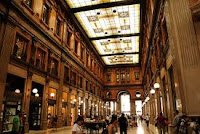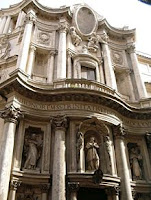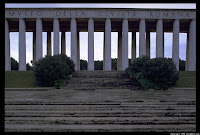For the quintessence of Fascist monumentalism, you couldn't do better than the EUR (Esposizione Universale di Roma/Universal Rome Exposition) complex, where Italy's overblown imperial ambition is represented in the configuration of space and in almost every building.
 To capture the colorful exuberance of Art Nouveau, there's no place in Rome better than Galleria Sordi, on via del Corso.
To capture the colorful exuberance of Art Nouveau, there's no place in Rome better than Galleria Sordi, on via del Corso. Tivoli, a town in the Alban Hills outside of Rome, has two such quintessential phenomena. One of them, the Villa d'Este, is famous and a mainstay of area tourism; the other, Villa Gregoriana, is not so well known. Yet Villa Gregoriana is in the RST Top 40--indeed, the RST Top 10--coming in at #6. Da non perdere (not to be missed).
Actually, we recommend seeing Villa d'Este and Villa Gregoriana in tandem, because they're so different, separated from each other by almost three centuries (the Villa d'Este was built in the mid-16th century, Villa Gregoriana dates to 1826) and representing distinct ways of looking at nature and the world. Although both are spectacular attractions, we've favored Villa Gregoriana because the 19th-century romantic perspective that it so perfectly captures--the visual equivalent of the poetry of Keats, Shelley, and Wordsworth--is rare in Rome, especially compared to the neo-classical perspective of the Villa d'Este.
The two villas are central to Itinerary 14 in Rome the Second Time, "Walking and Climbing Amid the Waters of Tivoli," where we provide guidance on how to get to Tivoli and what to take with you. We also offer our own, non-guide-book interpretation of the contrasting meanings of the two villas:
"Villa d'Este is all about control, order, precision, repetition, and technology; one gets the sense here of human beings making water do tricks, of water engineers engaged in modern, scientific acts of manipulation, of nature bent to human will, to the logic of science. In contrast, Villa Gregoriana is about an apparent lack of control, about the power of water to erode and carve, about singularity rather than repetition, about a ferocious nature barely restrained. Villa d'Este offers a lesson on the mind, a discourse on reason; Villa Gregoriana provides instructions on the body, on the spirit."
And there's more.
Bill





No comments:
Post a Comment